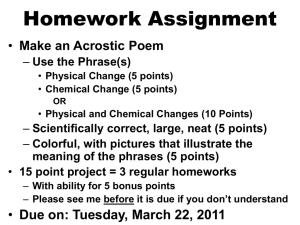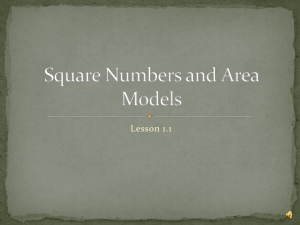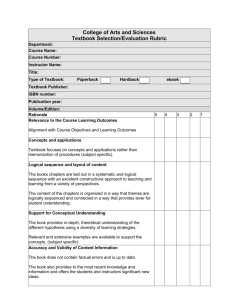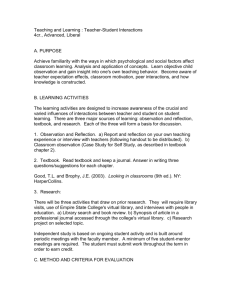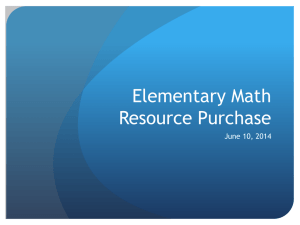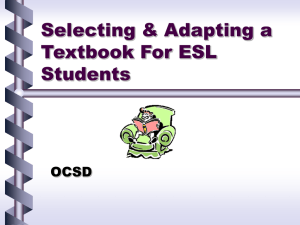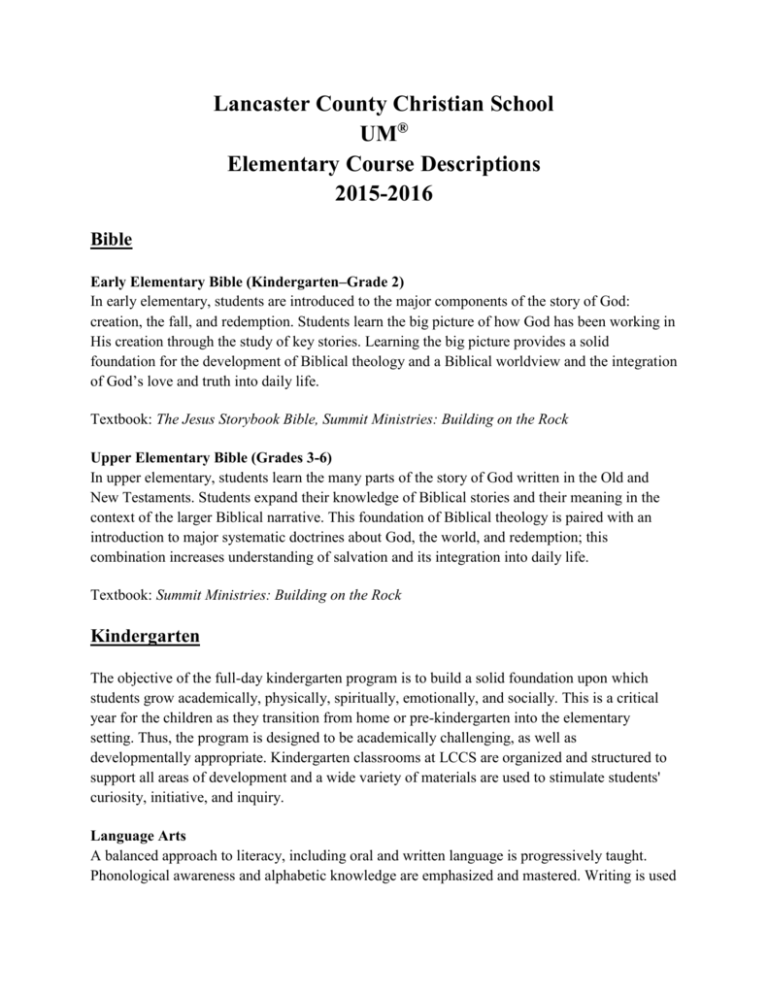
Lancaster County Christian School
UM®
Elementary Course Descriptions
2015-2016
Bible
Early Elementary Bible (Kindergarten–Grade 2)
In early elementary, students are introduced to the major components of the story of God:
creation, the fall, and redemption. Students learn the big picture of how God has been working in
His creation through the study of key stories. Learning the big picture provides a solid
foundation for the development of Biblical theology and a Biblical worldview and the integration
of God’s love and truth into daily life.
Textbook: The Jesus Storybook Bible, Summit Ministries: Building on the Rock
Upper Elementary Bible (Grades 3-6)
In upper elementary, students learn the many parts of the story of God written in the Old and
New Testaments. Students expand their knowledge of Biblical stories and their meaning in the
context of the larger Biblical narrative. This foundation of Biblical theology is paired with an
introduction to major systematic doctrines about God, the world, and redemption; this
combination increases understanding of salvation and its integration into daily life.
Textbook: Summit Ministries: Building on the Rock
Kindergarten
The objective of the full-day kindergarten program is to build a solid foundation upon which
students grow academically, physically, spiritually, emotionally, and socially. This is a critical
year for the children as they transition from home or pre-kindergarten into the elementary
setting. Thus, the program is designed to be academically challenging, as well as
developmentally appropriate. Kindergarten classrooms at LCCS are organized and structured to
support all areas of development and a wide variety of materials are used to stimulate students'
curiosity, initiative, and inquiry.
Language Arts
A balanced approach to literacy, including oral and written language is progressively taught.
Phonological awareness and alphabetic knowledge are emphasized and mastered. Writing is used
to help the students put their letter knowledge and letter writing into practice, along with correct
letter formation. During sharing time, students practice public speaking skills including speaking
in complete sentences, maintaining proper volume and keeping eye contact.
Textbook: Sounds and Letters Workbook-SRA/ McGraw-Hill Open Court Reading; Reading A-Z,
Word Journeys by Kathy Ganske, Kidwriting, Modern Curriculum Press Plaid Phonics
Mathematics
The student is introduced to a wide variety of math concepts and skills, such as sorting, position,
counting to 100, recognizing numbers to thirty-one, place value of tens and ones, time to the
hour, value of coins, reading bar and pictographs, beginning measurement, patterning, geometric
figures, and beginning addition and subtraction.
Textbook: Math Connects-Macmillan/McGraw-Hill
Science
The students learn facts about different animals and their habitats. Dental health is discussed and
experiments are observed. Changes of the seasons, fire safety, and plant growth/needs are also
introduced and discussed.
Textbook: Scholastic-Let’s Find Out Newspapers
Social Studies
Students learn about most holidays that are celebrated and the important people associated with
them, such as Dr. Martin Luther King Jr., George Washington, and Abraham Lincoln. The
students learn appropriate social skills and conflict resolution skills.
Textbook: Scholastic-Let’s Find Out newspapers
Art
The class will be introduced to the basics related to color, line, and shape. Students will complete
short projects as they learn how these concepts relate to the artwork they create. Students will
find inspiration from the world around them and from grade specific literature. The students will
be able to visually identify major artists and their art work. Clean-up procedures will be
regimented so students begin to understand their role during part of class.
Music
Music K is designed to prepare the kindergarten student for music reading and performance.
Through singing, reading, moving, playing, echoing and activities presented within the course,
the students will obtain the skills necessary to provide a foundation for music literacy.
Physical Education
The student will be able to know the positive effects of regular participation in physical activity,
recognize changes in body response during physical activity, and recognize and use basic
movement skills and concepts.
First Grade
First graders at Lancaster County Christian School learn the joy of reading books independently,
develop an awe of God's world around them, and learn how to be good friends. This is an
exciting year for these eager, high-energy children with sensitive hearts that are open to hearing
God's Word.
Language Arts
Children develop a strong basis in reading through daily participation in the five components of
the elementary Comprehensive Literacy Program, including Read Aloud, Independent Reading,
Word Study, Guided Reading, and Handwriting and Writing.
Textbook: SRA Open Court Reading; Reading A-Z; Leveled Readers/Trade Books
Spelling: Word Journeys
Mathematics
First graders learn the basic addition and subtraction facts, basic geometric shapes and fractions,
measurement, money, and time. A number sense develops as students work on place value and
participate in numerous hands-on activities.
Textbook- Houghton Mifflin Math,
Science
First graders learn about God’s purposeful design through the following topics: fish, insects,
animals, seasons, human body, birds, and movement.
Textbook- ACSI Purposeful Design,
Social Studies
Children learn that history is God's story as they study our changing world; the first Americans
and the Pilgrims; rules and laws; and where people live. Students also learn how America began,
with emphasis on America's godly heritage.
Textbooks-Houghton Mifflin/Harcourt Social Studies
Music
Music one is designed to provide students in the first grade with experiences to prepare them for
music reading. Through singing, playing simple instruments, moving, writing, and a variety of
activities presented within the course, the students demonstrate their growth in music literacy.
The classroom materials provide the student with songs and activities to build singing and
coordination skills, as well as to introduce new concepts in music reading. As the students learn
to match pitch and use expression, they are reminded to use their skills and talents to glorify
God.
Art
The class will be introduced to the basics related to color, line, and shape. They will also be able
to identify and create both portraiture and landscapes. Students will complete short projects as
they learn how these concepts relate to the artwork they create. The students will be able to
visually identify major artists and their art work. Clean-up procedures will be regimented and
defined so students begin to understand their role during part of class.
Physical Education
The student will know the positive and negative effects and recognize changes in body response
during participation in physical activity. The student will identify likes and dislikes related to
physical activity; recognize positive interaction of small group activities, practice locomotor
skills, manipulative skills, and space awareness. The student will know and describe scientific
principles that affect movement skills (balance).
Second Grade
Language Arts
Students will learn phonemic awareness, decoding, and comprehension skills through reading
various thematic stories in different genres. Students write stories and poetry while applying the
rules of grammar and mechanics. Students learn cursive writing and continue to develop
manuscript handwriting formation.
Textbook: SRA Open Court Reading; Reading A-Z; Leveled Readers/Trade Books; Daily
Grammar, Explode the Code
Spelling: Word Journeys
Mathematics
Students in second grade use various materials and manipulatives to learn place value up to the
thousands place. They use place value knowledge for addition and subtraction with regrouping.
Students learn how to tell exact time, identify two-dimensional and three-dimensional shapes,
and learn beginning fraction and measurement concepts as well as introducing multiplication at
the end of the year. Students learn the value of money and how to add and subtract money.
Students apply these concepts and learn many different problem-solving strategies.
Textbook: Math Connects, Macmillan McGraw-Hill
Science
Students will explore the beautiful world we live in and will cover topics such as ecosystems,
personal health, invertebrates, forms of light, meteorology and the five senses.
Textbook- ACSI Purposeful Design and various trade books
Social Studies
Students learn about government and communities, maps and world regions, natural resources,
American heritage and heroes, and world cultures.
Textbook: Houghton Mifflin/Harcourt Social Studies and various trade books
Art
The class will be introduced to the basics related to color, line, and shape. They will also be able
to identify and create both portraiture and landscapes. Students will complete short projects as
they learn how these concepts relate to the artwork they create. The students will be able to
visually identify major artists and their art work. Clean-up procedures will be regimented and
defined so students begin to understand their role during part of class.
Music
Music Two is designed to provide students in the second grade with experiences to prepare them
for music reading. Through singing, playing simple instruments, moving, writing, and a variety
of activities presented within the course, the students demonstrate their growth in music literacy.
The classroom materials provide the student with songs and activities to build singing and
coordination skills, as well as to introduce new concepts in music reading. As the students learn
to match pitch and use expression, they are reminded to use their skills and talents to glorify
God.
Physical Education
The student will identify and engage in physical activities that promote physical fitness and
health, identify likes and dislikes related to participation in physical activity, recognize positive
and negative interactions of small group activity, recognize and use basic movement skills and
concepts, know the function of practice, know and describe scientific principles that affect
movement, recognize and describe game strategies using appropriate vocabulary.
Third Grade
Language Arts
Students will read theme-based stories in various literary forms such as picture books,
informational articles, and poetry. A strong emphasis is placed on phonics. Students are
introduced to the writing process. In their own writing, they will incorporate grammar and
spelling rules and will continue to develop their cursive writing skills.
Textbook: SRA Open Court Reading; Reading A-Z; Leveled Readers/Trade Books
Spelling: Word Journeys, Easy Grammar
Mathematics
Third grade students order and estimate numbers through the hundred thousands before moving
on to review regrouping to the thousands place. They also learn the concepts of multiplication
and division, with a strong focus on memorizing these facts. Students are also introduced to
fractions and basic units of measurement.
Textbook: Math Connects and Impact Macmillan McGraw-Hill
Science
Through a variety of hands-on activities, students strengthen their observational skills and the
complexity of God’s Creation through a life science study of ecosystems. They learn about His
order through a physical science study of matter, energy, and sound and light waves.
Textbook: ACSI Purposeful Design (YEAR), ACSI Systems
Social Studies
Third grade learns a lot about communities and how they are formed. Students will study how
and why communities are founded, and how they change over time. They will look at current
communities as well as historical communities, both locally and around the world.
Textbook: Houghton Mifflin/Harcourt Social Studies
Art
Students will be introduced to new art materials and how they relate to the materials used in the
previous grades. They will continue to apply these lessons to the elements of art while slowly
beginning to understand the principles of design. Their art vocabulary will be expanded through
in class discussions related to artwork created by the masters. The class will be introduced to
several cultures around the world and create projects related to their discoveries. Students will
learn their role in the maintenance of art supplies and the art room. Clean up procedures will be
regimented and defined so students understand their role in the class.
Music
Class time is devoted to exploring and composing, listening and analyzing, singing and
performing, reading and interpreting a musical score as it pertains to the treble clef. Specific
components of 3rd grade music include aural recognition and performance of meter in 2 and 3,
expressive interpretation (soft, loud, crescendo/decrescendo) and learning to sing basic harmonic
structures (i.e. 2 pt rounds and 2 partner songs and rhythmic/melodic ostinatos), and
vocal/instrumental timbre from a wide variety of musical styles and genres. The study of
recorder is an integral part of the 3rd grade general music curriculum which includes learning the
names of the treble clef lines/spaces, basic rhythm, reading a musical score, correct
fingering/finger placement, caring for a musical instrument and playing together in an ensemble.
Physical Education
The student will be able to identify and engage in physical activity that promotes physical
fitness, identify reasons why regular participation in physical activity improves motor skills,
recognize positive and negative interaction of small group activities, recognize and use basic
movement skills and concepts, recognize and describe the concepts of motor skill development
using appropriate vocabulary, identify and use principles of exercise to improve movement and
fitness and recognize game strategies. They also learn the basics of the following sports: football,
softball, soccer, basketball, street hockey, handball, indoor soccer, gymnastics, lacrosse,
volleyball, frisbee, and track and field. The student will participate in the President’s Challenge
Test.
Computers
Students will begin a base knowledge of the basic components of computer and peripheral
devices. Typing skills will learned and students will work through the use of a typing program.
Evaluation of their typing speed and accuracy will be a part of their overall grade. Students will
learn how to use new software as part of their class projects.
Fourth Grade
Language Arts
Students read a combination of short stories from an anthology and trade books, while
implementing reading strategies and analyzing literature elements. In the anthology component,
students read story selections and excerpts, biographies, and folktales. Students learn grammar
rules and practice legible handwriting. Students learn about and practice using the 6 + 1 Traits of
writing and the writing process as they practice writing various fiction and nonfiction pieces, and
revising and editing them. Students learn phonetic-based spelling words with a focus on spelling
structure.
Textbook: Houghton Mifflin Reading; Reading A-Z; Leveled Readers/Trade Books; 6 + 1 Traits
of Writing; Easy Grammar; Spelling: Word Journeys
Mathematics
Students order, compare, and estimate whole numbers through the millions place. They add,
subtract, multiply, and divide numbers through the thousands place. Special attention is given to
working on mastering math facts in all four operations. The focus is on refining multi-digit
multiplication skills and learning how to tackle long division. They explore geometry and
identify shapes (2-D & 3-D), triangles, quadrilaterals, angles, perimeter, and area. They review
both systems of measurement, also. They learn how to manipulate fractions and decimals by
comparing them. Math strategies, manipulatives, and word problems are heavily emphasized.
Textbook: Macmillan McGraw-Hill Math Connects
Science
Fourth grade science focuses on earth science and the human body. Earth and Space science will
focus on rocks and soil, the earth's surface (the lithosphere), changes in the earth’s surface, the
hydrosphere, the atmosphere, and the universe. The Human Body unit will focus on the various
different body systems, including the musculoskeletal, nervous, circulatory, immune, respiratory,
and digestive. Health and wellness is also highlighted. Heavy emphasis is placed on God’s
purposeful design. Science is studied by a variety of methods in these units.
Textbook: ACSI Purposeful Design
Social Studies
In fourth grade social studies, students will focus on Pennsylvania history and geography and
United States regions and geography. Students learn about Pennsylvania’s land features, its
history, its participation in historical events, and its important people in government. United
States geography is studied in the five regions that make this nation so diverse. The land and
people of each region is studied with facts that make each region distinct. Student also
memorize the 50 states and capitals in this unit.
Textbook: Scott Foresman (Pennsylvania) & Scott Foresman (Regions)
Art
Students will be introduced to new art materials and how they relate to the materials used in the
previous grades. They will continue to apply these lessons to the elements of art while slowly
beginning to understand the principles of design. Their art vocabulary will be expanded through
in class discussions related to artwork created by the masters. The class will be introduced to
several cultures around the world and create projects related to their discoveries. Students will
learn their role in the maintenance of art supplies and the art room. Clean up procedures will be
regimented and defined so students understand their role in the class.
Music
Class time is devoted to exploring and composing, listening and analyzing, singing and
performing, reading and interpreting a musical score as it pertains to the treble clef. Specific
components of 3rd and 4th grade music include aural recognition and performance of meter in 2
and 3, expressive interpretation (soft, loud, crescendo/decrescendo) and learning to sing basic
harmonic structures (i.e. 2 pt rounds and 2 partner songs and rhythmic/melodic ostinatos), and
vocal/instrumental timbre from a wide variety of musical styles and genres. The study of
recorder is an integral part of the 4th grade general music curriculum which includes learning the
names of the treble clef lines/spaces, basic rhythm, reading a musical score, correct
fingering/finger placement, caring for a musical instrument and playing together in an ensemble.
In addition, string and orchestra opportunities are available for grades 4-8.
Physical Education
The student will identify ways to monitor the body’s response to moderate to vigorous activity,
describe factors that affect their physical activity preferences, identify factors of a relationship
between regular participation in physical activity and the degree of motor skill development,
identify positives and negatives to group interactions (teamwork), apply the concepts of motor
skill development to basic sport and activity skills, describe the relationship between practice and
skill development and the principles of exercise. They also learn the basics of the following
sports: football, softball, soccer, street hockey, handball, basketball, indoor soccer, gymnastics,
lacrosse, volleyball, frisbee, and track and field. The student will participate in the President’s
Challenge Test.
Computer
Students will learn how the individual parts of a computer and peripheral devices work together.
Typing skills will continue to be enhanced through the use of a typing program. Evaluation of
their typing speed and accuracy will be part of their overall grade. Projects geared to expanding
the creative aspects of the computer and its software will be highlighted.
Fifth Grade
Language Arts
Students will learn phonetic-based spelling words, learn and apply vocabulary terms, and
practice grammar rules and the parts of speech. Students will also write original creative works,
as well as informational reports. Student reading covers a number of different genres and themes
and students are expected to read and respond to many books independently throughout the year.
Textbook: Houghton Mifflin Reading
Textbook: Easy Grammar
Textbook: Spelling: Word Journeys
Mathematics
Students work with adding, subtracting, multiplying, and dividing whole numbers, as well as
showing place value. They will study fractions, multiples, and factors. Students add and subtract
decimals and fractions. They do hands-on algebra and solve algebraic expressions. Students
display and interpret data and solve equations and function tables. Customary and metric
measures are studied; in addition, geometric figures and perimeter, area, and volume problems
are solved.
Textbook: Macmillan McGraw-Hill Math Connects
Science
Students build upon their knowledge of life science by studying natural and life cycles, cells and
ecological succession. They will also explore physical science to learn about matter, force, and
electricity. Earth and Space science processes are studied as well as the human body.
Textbook: ACSI Purposeful Design
Textbook: Answers in Genesis Science
Social Studies
Students begin their world geography study learning core concepts: map skills, climates and
ecosystems, economics and geography. Students study the culture, geography, government and
history of the United States, Canada, Middle America, South America, Europe and Russia,
Africa, Asia, Australia and the Pacific.
Textbook: Pearson My World Geography
Art
Students will create artwork that expresses their point of view as a young Christian artist. They
will learn how to manipulate new and interesting art material. The class will learn the role artist
have on society and create projects that emulates this work. Elementary vocabulary will reach its
highest point and students will be expected to communicate with the teacher using the language
they have learned. The class revolves around learning the basic use and application of the
elements of design. Students will have individual and group clean-up assignments that will
challenge them to become more responsible.
Music
Class time is devoted to refining and strengthening musical components as a capstone for the
elementary music curriculum and also as a foundation for Middle School music. Class time is
devoted to advanced exploration, analysis and performance of the various music families
(strings, percussion, woodwinds, and brass), as well as developing correct singing techniques.
Students learn to recognize, define, and interpret basic music elements, such as treble/bass clef
note names, note/rest durations, time signature, and expressive markings. In addition, string and
orchestra opportunities are available for grades 4-8.
Physical Education
Students build muscular and respiratory endurance, learn the art of interpretive dance, participate
in low ropes activities and the President’s Challenge, and take the Kraus and Webber test. They
also learn the basics of the following sports: football, softball, soccer, field hockey, street
hockey, handball, indoor soccer, gymnastics, lacrosse, volleyball, frisbee, and track and field.
Computer
Students will learn to identify all the internal components of the computer. Typing skills will
continue to be enhanced through the use of typing programs. Evaluation of their typing speed
and accuracy will be part of their overall grade. Projects centered on imagination will highlight
the student’s knowledge of programs learned within the elementary curriculum.
Spanish
Review of previously taught in 2nd, 3rd and 4th. We will review the alphabet. The will learn
vocabulary such as days of the week, months of the year, parts of the body, colors and simple
commands through games and songs.
Sixth Grade
Social Studies: United States History I
United States History One studies history from the early populating of the continent through
European discovery, colonization, and the War for Independence, with a focus on God’s
providential hand at work. Instruction is varied by using textbooks, student research projects,
video, field trips, artifacts, and presentations.
Textbooks: The American Journey – The Early Years-Glencoe
Mathematics
Students will review whole number and decimal concepts. Students will be able to add, subtract,
multiply, and divide fractions. Students will study geometry and explore reflections, rotations,
and translations. Students will be able to use the metric and customary system to convert units.
Using graphs to compare data sets will also be a focus. Students will work with ratio, proportion,
percent, and probability. Students will be able to calculate a variety of measurements. Students
will be introduced to the coordinate plane and integers.
Textbook: Mathematics Course 1-Pearson/Prentice Hall
Science
Students explore the physical world of matter and atoms with their chemical changes, electrical,
light, and sound energy transfers. We will also cover the plant and animal biological world in
regards to how they respond to climate and other stimuli. Finally, an overview of our changing
planet and the space surrounding it will be covered in this class.
Textbook: ACSI Purposeful Design
English
Students will practice identifying and using the parts of speech. In writing, students will produce
both creative works, as well as learning the process of writing a research paper. Students will
read and analyze short stories and novels as a class, and will be expected to read extensively on
their own. Focusing their word study on Greek and Latin word parts, students will expand their
vocabulary knowledge and use.
Textbooks include: Easy Grammar, Vocabulary from Classical Roots – Book 6, as well as
supplemental literature from various sources, and Teaching Writing: Structure and Style from
the Institute for Excellence in Writing, The Reader’s Journey (Prentice Hall)
Music
Class time is devoted to refining and strengthening musical components as a capstone for the
elementary music curriculum and also as a foundation for Middle School music. Class time is
devoted to advanced exploration, analysis and performance of the various music families
(strings, percussion, woodwinds, and brass), as well as developing correct singing techniques.
Students learn to recognize, define, and interpret basic music elements, such as treble/bass clef
note names, note/rest durations, time signature, and expressive markings. In addition, string and
orchestra opportunities are available for grades 4-8.
Art
Students will create artwork that expresses their point of view as a young Christian artist. They
will learn how to manipulate new and interesting art material. The class will learn the role artist
have on society and create projects that emulates this work. Elementary vocabulary will reach its
highest point and students will be expected to communicate with the teacher using the language
they have learned. The class revolves around learning the basic use and application of the
elements of design. Students will have individual and group clean-up assignments that will
challenge them to become more responsible.
Physical Education
Students will learn to appreciate and care for their bodies as temples of the Holy Spirit. Each
student is created in the image of God and possesses a variety of gifts and abilities which
students must discover and strengthen. Students will be taught the importance of life long fitness
and will be given opportunity to perform a variety of activities. Students will participate in the
President’s Challenge yearly as well as other skills tests. Students will be introduced to a variety
of sports and will learn proper technique, vocabulary, strategy and given the opportunities to
compete.
Computer Technology
Students will learn to identify the internal components of a computer and understand their use in
the computer’s operation. Typing skills will continue to be an important aspect of their computer
class experience. Evaluation of their typing speed and accuracy will be part of their overall
grade. Students will compare and contrast Microsoft Office with that of Google Apps. Projects
related to both software packages will stress the need for students to have a diverse
understanding of programs and how they relate.

